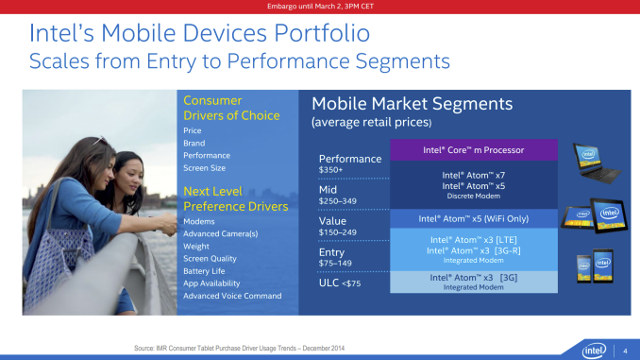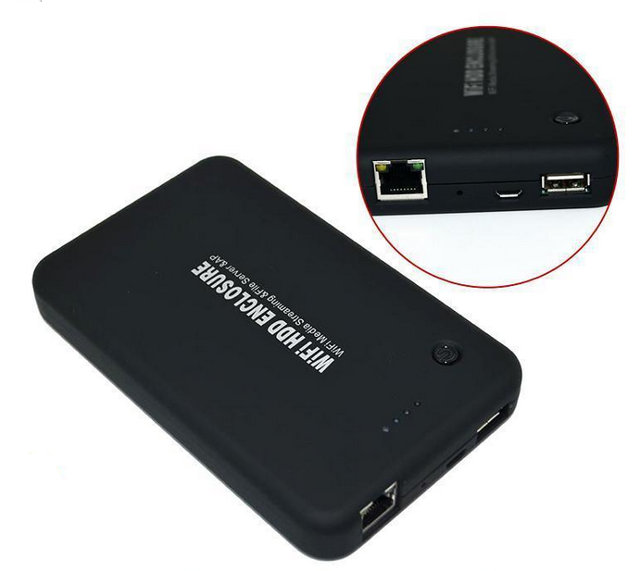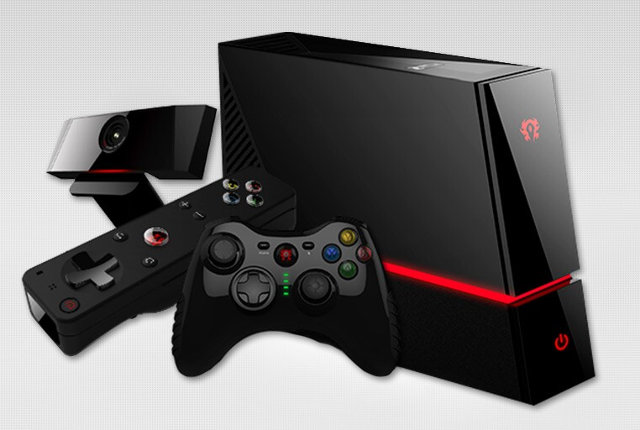Intel had already announced their plan to change Intel Atom branding to use x3/x5/x7 nomenclature in order to make it easier for consumers to navigate their product offerings, but the company has now provided much more details during their press conference at Mobile World Congress 2015. Intel Atom x3 (previously known as SoFIA) will be entry and ultra-low cost processor up with 3G or LTE connectivity found in products up to around $150, while Atom x5 and x7 (previously known as Cherry Trail) will be found in tablets between about $200 to $400, with the top performing devices going with Intel Core M processors. Intel Atom x3 are very interesting because they mix Intel 64-bit cores with ARM GPUs (to keep the cost down), and parts with RK suffix are made by Rockchip. Three x3 processors are currently available: Intel Atom x3-C3130 – Dual-core processor up to 1.0 GHz with […]
$35 Bluetooth Blood Pressure Monitor Works with Android and iOS
People with hypertension or other heart conditions may want to monitor their blood pressure daily, and since I was asked recently, I studied blood pressure monitors available on the market from Chinese websites. The simplest ones that simply display the results on an LCD are quite inexpensive since they cost about $15 shipped, unless you buy brands like Omron. You’d then need to enter the data in a spreadsheet or on paper after each measurements, so you’d rather have the process more streamlined, you could consider a Bluetooth version that will automatically keep measurements stored in your Android or iOS smartphone, such as the model below that sells for around $35 on Aliexpress and Ebay. Key features for this unnamed digital blood pressure monitor Display – 70 x 55mm; 3x 3 Digits lines for systolic and diastolic pressures, and heart rate; Memory/Heartbeat/Low battery indication Measurements: Oscillometric method Pressure Range- 0 […]
Add Network Connectivity to 2.5″ SATA Drives With Wi-Fi & Ethernet Enclosures
One person asked if there were solution to add Wi-Fi or Ethernet to hard drives similar to what Zsun Wifi Card Reader does with micro SD card. Provided solution include buying a low cost router with USB such as TP-Link WR703N, and the Pogoplugs which are pretty good, especially since you can install Debian or Arch Linux ARM, but are only available at low cost if you live in North America. But I’ve now been made aware of 2.5″ SATA HDD enclosures selling for around $40 that also come with Wi-Fi and Ethernet, and provide a compact way to add networking to hard drives. Specifications for the aforelinked Wi-Fi HDD Enclosure: Connectivity 802.11 a/b/g/n Wi-Fi. Modes: AP + Client; AP + WAN Bridge; AP + WAN router Ethernet 3G possible via USB port HDD – Supports up to 2TB HDD USB – 1x micro USB port for charging, 1x USB […]
Samsung Galaxy S6 and S6 Edge Octa-core Smartphones Support Two Wireless Charging Protocols and UFS 2.0 Flash
Samsung Electronics announced Galaxy S6 and Galaxy S6 Edge smartphones at Mobile World Congress 2015 during their “Unpacked” event. Both features Exynos 7420 octa-core SoC with 64-bit ARM cores, and 5.1″ display, bit the Galaxy S6 Edge display is curved on both sides. Galaxy S6 & S6 Edge specifications: SoC – Samsung Exynos 7 Octa (Exynos 7420) octa core processor with four Cortex A57 core @ 2.1GHz + four Cortex A53 cores @ 1.5Ghz, and Mali-T760 MP8 GPU, manufactured using 14nm process. System Memory – 3GB LPDDR4 Storage – 32, 64 or 128GB UFS 2.0 flash. Display Galaxy S6 – 5.1’’ Quad HD(2560×1440) 577ppi, Super AMOLED. Gorilla Glass 4. Galaxy S6 Edge – 5.1’’ Quad HD(2560×1440) 577ppi, Super AMOLED, Dual edge. Gorilla Glass 4. Camera 16MP OIS(rear), 5MP (front). Features: Quick Launch (0.7s by pressing the home button twice), Tracking AF, Auto Real-time HDR(Front & Rear) , F1.9, Low Light Video(Front […]
Huawei Watch May Be the Best Looking Android Wear Smartwatch So Far
If you think Motorola Moto 360 looks good, but find the black zone at the bottom of the display ruins it all, Huawei Watch may be what you’ve been looking for, with a similar rounded shape design, Android Wear, and when it is in watch mode it really looks like a standard watch without obstructions. Let’s go through the specifications first: SoC – Qualcomm Snapdragon 400 (APQ8026) quad core Cortex A7 @ 1.2GHz with Adreno 305 GPU System Memory – 512MB RAM Storage – 4GB ROM Display – 1.4″ full circle AMOLED display; 400×400, 286ppi; Sapphire crystal Audio – Built-in MIC Connectivity – Bluetooth 4.0/4.1 Sensors – Gyroscope + Accelerometer, PPG (photoplethysmogram – for heart rate), Barometer, Vibration Motor Misc – Watch button at 2 o’clock Battery – 300mAh Material – Watch: 316L Stainless Steel; Watchband: stainless steel or leather Dimension – 42mm diameter by 11.3mm thickness Weight – […]
Mediatek MT8173 is a big.LITTLE Cortex A72 / A53 Quad Core Processor for Tablets
Mediatek MT8173 first showed up in the Linux kernel as a quad core Cortex A57 / A53 processor, but now that Mediatek has officially announced the processor, it turns out the Cortex A57 cores are actually the new Cortex A72 cores, with a similar architecture, but more powerful, about 1.8 times faster. Key features listed by the company: Processor – Heterogeneous 64-bit Multi-Core big.LITTLE architecture up to 2.4GHz featuring ARM Cortex-A72 and ARM Cortex-A53 64-bit CPU. Big cores and LITTLE cores can run at full speed at the same time for peak performance requirement GPU – Imagination PowerVR GX6250 GPU with support for OpenGL ES 3.1, OpenCL. Performance: 350Mtri/s and 2.8 Gpix/s. Display Support WQXGA display (2560×1600) up to 60 Hz with TV-grade picture quality enhancement. Up to 120 Hz mobile display for other resolutions. HDMI and Miracast support for multi-screen applications Video – Ultra HD 30fps H.264/HEVC(10-bit)/VP9 hardware video […]
Warchief Nvidia Tegra K1 Android Game Console Supports Kinect-like 3D Motion Tracking
Nvidia Tegra K1 is still the one of the best low power processor for gaming with its 192-core Kepler GPU, and a few Chinese manufacturers are about the launch mini PCs or game console featuring the 32-bit and/or 64-bit version of the processor. Warchief is one of those products. It’s sold as an Android game console with a gamepad, a motion controller, and a webcam used for motion detection. Warchief specifications: SoC – Nvidia Tegra K1 quad core Cortex A15 processor with a 192-core Kepler GPU System Memory – 2GB DDR3 Storage – 32GB eMMC Video Output – HDMI Connectivity – Ethernet, 802.11 b/g/n Wi-Fi, Bluetooth 4.0 USB – 4x USB 2.0 ports Power Supply – TBD Dimensions – 340 x 235 x 110 mm The package also include the Wii-like remote, a wireless gamepad, the camera, a power supply, a small USB dongle (for the remote or gamepad), and […]
Meizu MX4 Ubuntu Edition Octa-core Smartphone to be Unveiled at MWC 2015
BQ Aquaris E4.5 Ubuntu Edition may have been the first phones launched with Ubuntu operating systems, but the device is rather an entry-level smrtphone with Mediatek MT6582 quad core Cortex A7 processor and 1GB RAM. If you’d like a much faster and powerful Ubuntu phone, Meizu MX4 Ubuntu Edition will be announced at Mobile World Congress 2015. The specs has not been disclosed yet, but it’s highly likely the hardware will be the same as the Android version of Meizu MX4: SoC – MediaTek MT6595 octa core processor with 4 Cortex A17 @ 2.2GHz, and 4 Cortex A7 @ 1.7GHz in big.LITTLE configuration with a PowerVR G6200 GPU. System Memory – 2GB dual-channel LPDDR3 RAM, 933MHz Storage – 16, 32, or 64GB eMMC Display – 5.36″ IPS touchscreen; 1920×1152 resolution; Corning Gorilla Glass 3 Camera – 20.7MP rear camera with dual tone LED flash, 2MP front-facing camera Audio – 3.5mm […]













